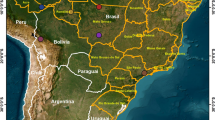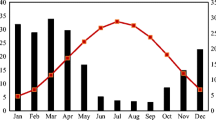Abstract
In this paper, we employed an autoregressive integrated moving average (ARIMA) model to simulate aerosol optical depth time series from the ground-based AErosol RObotic NETwork (AERONET) from 2012 to 2021. To test the validity and applicability of the developed ARIMA model, we correlated the ARIMA predicted for 2021 with AERONET network data and obtained a correlation coefficient of ~ 0.9. Additionally, we compared the results with the space-based Moderate Resolution Imaging Spectroradiometer (MODIS) data for the Middle East and obtained a considerable correlation coefficient of ~ 0.5. We employ the threshold of the Angstrom exponent (AE) as a measure of the spectral dependence of aerosol optical depth (AOD), which ranges between 0 and 1, to characterize aerosol types. The results show weighted averages of AOD ≥ 0.2 and AE ≥ 1.0 for fine-mode aerosol spray in IASBS (36.705 N, 48.507 E), AOD > 0.2 and AE < 1.0 for dust aerosols in Nes_Ziona (31.922 N, 34.789 E), AOD > 0.4, 0.5 < AE < 1.0 for dust and maritime aerosol for Masdar _Institute station (24.442 N, 54.617 E) and AE < 1, AOD ≤ 0.5 for dust and maritime aerosol in Hada_El-Sham (21.802 N, 39.729E).




Similar content being viewed by others
Data Availability
Data are available upon request.
References
Abish B, Mohanakumar K (2013) A stochastic model for predicting aerosol optical depth over the north Indian region. Int. J. Remote Sens. 34:1449–1458
Alam K, Iqbal MJ, Blaschke T, Qureshi S (2010) Monitoring spatiotemporal variations in aerosols and aerosol–cloud interactions over Pakistan using MODIS data Gulzar khan. Adv. Space Res. 46:1162–1176
Anoruo CM (2020) Space and Ground-based remote sensing comparison of seasonal Interaction of Aerosol-Cloud-Precipitable Water. Atoms Environ 243:117864
Anoruo CM (2021) Subseasonal aerosol characterization at the Middle East regions of AERONET site. Urban Clim. 37(2021):100827. https://doi.org/10.1016/j.uclim.2021.100827
Anoruo CM, Ibe OC, Ndubuisi KN (2022a) Aerosol load-cloud cover correlation: a potential clue for the investigation of aerosol indirect impact on climate of Europe and Africa. Aerosol Sci. Eng. https://doi.org/10.1007/s41810-022-00160-7
Anoruo C (2022b) Monsoon-seasonal validation of MODIS aerosol optical depth and characterization using AERONET observation retrieve over Italy. Environ. Res. 204(2022):111985
Ballester EB, Valls GC, Carrasco-Rodriguez JL, Olivas ES, del Valle-Tascon S (2002) Effective 1-day ahead prediction of hourly surface ozone concentrations in Eastern Spain using linear models and neural networks. Ecol. Model. 156:27–41
Boucher O et al (2013) Clouds and aerosols. In: Stocker TF, Qin D, Plattnes G-K, Tignos M, Allen SK, Boshung J, Midgley PM (eds) Climate Change 2013: the Physical Science Basis. Contribution of Working Group I to the Fifth Assessment Report of the Intergovernmental Panel on Climate Change. Cambridge University Press, Cambridge
Box GEP, Jenkins GM, Reinsel GC (2008) Time Series Analysis: Forecasting and Control, 4th edn. John Wiley & Sons, Inc., U.K.
Che H, Qi B, Zhao H, Xia X, Eck TF, Goloub P, Dubovik O, Estelles V, Cuevas-Agulló E, Blarel L, Wu Y (2018) Aerosol optical properties and direct radiative forcing based on measurements from the China Aerosol Remote Sensing Network (CARSNET) in eastern China. Atmos. Chem. Phys. 18:405–425
Chin M, Diehl T, Tan Q, Prospero JM, Kahn RA, Remer LA, Yu H, Sayer AM, Bian H, Geogdzhayev IV, Holben BN, Howell SG, Huebert BJ, Hsu NC, Kim D, Kucsera TL, Levy RC, Mishchenko MI, Pan X et al (2014) Multidecadal aerosol variations from 1980 to 2009: a perspective from observations and a global model. Atmos. Chem. Phys. 14:3657–3690
Chudnovsky AA et al (2017) Spatial and temporal variability in desert dust and anthropogenic pollution in Iraq, 1997–2010. J. Air Waste Manage. Assoc. 67(1):17–26. https://doi.org/10.1080/10962247.2016.1153528
Dubovik O, King MD (2000) A flexible inversion algorithm for retrieval of aerosol optical properties from Sun and sky radiance measurements. J. Geophys. Res. 105(20):696, 673–696, 620
Dubovik O, Holben BN, Eck TF, Smirnov A, Kaufmann YJ, King MD, Tanre D, Slusker I (2002) Variability of absorption and optical properties of key aerosol types observed in worldwide locations. J.Atmos. Sci. 59:590–608
Eck TF, Holben BN, Dubovic O, Smirnov A, Goloub P, Chen HB, Chatenet B, Gomes L, Zhang XY, Tsay SC, Ji Q, Giles D, Slutsker I (2005) Columnar aerosol optical properties at AERONET sites in central eastern Asia and aerosol transport to the tropical mid-Pacific. J. Geophys. Res. 110(D06202). https://doi.org/10.1029/2004JD005274
Eck TF, Holben BN, Reid JS, Dubovic O, Smirnov A, O’Neil NT, Slutsker I, Kinne S (1999) Wavelength dependence of the optical depth of biomass burning, urban, and desert dust aerosols. J. Geophys. Res. 104(D24):31 333–31 349
Garibzadeh M, Alam K (2019) Study of aerosol optical properties in the Middle East during. Desert 2(24)
Guirado C, Cuevas E, Cachorro VE, Toledano C, AlonsoPerez S, Bustos JJ, Basart S, Romero PM, Camino C, Mimouni M, Zeudmi L, Goloub P, Baldasano JM, de Frutos AM (2014) Aerosol characterization at the Saharan AERONET site Tamanrasset. Atmos. Chem. Phys. 14:11753–11773
Holben BN, Tanre D, Smirnov A, Eck TF, Slutsker I, Abuhassan N, Newcomb WW, Schafer JS, Chatenet B, Lavenu F, Kaufman YJ, Castle JV, Setzer A, Markham B, Clark D, Frouin R, Halthore R, Karneli A, O’Neill NT et al (2001) Aerosol optical depth from AERONET. J. Geophys. Res. Atmos. 106:12067–12097
Horowitz HM, Garland RM, Thatcher M, Landman WA, Dedekind D, Merwe J, Engelbrecht FA (2017) Evaluation of climate model aerosol seasonal and spatial variability over Africa using AERONET. Atmos. Chem. Phys. 17:13999–14023
Johnson JS et al (2018) The importance of comprehensive parameter sampling and multiple observations for robust constraint of aerosol radiative forcing. Chem Phys Discuss Atmos. https://doi.org/10.5194/acp-2018-174
Kumar KR, Yin Y, Sivakumar V, Kang N, Yu X, Diao Y, Reddy RR (2015) Aerosol climatology and discrimination of aerosol types retrieved from MODIS, MISR and OMI over Durban (29.88°S, 31.02°E), South Africa. Atmos Environ. Times 117:9–18
Lee J, Kim J, Song CH, Kim SB, Chun Y, Sohn BJ, Holben BN (2010) Characteristics of aerosol types from AERONET sunphotometer measurements. Atmos. Environ. 44:3110–3117
Lee LA, Reddington CL, Carslaw KS (2016) On the relationship between aerosol model uncertainty and radiative forcing uncertainty. Proc Natl Acad Sci 113:5820–5827
Liang WM, Wei HY, Kuo HW (2009) Association between daily mortality from respiratory and cardiovascular diseases and air pollution in Taiwan. Environ Res. 109:51–58
Michibata T, Suzuki K, Sato Y, Takemura T (2016) The sources of discrepancies in aerosol-cloud- precipitation interactions between GCM and A-train retrievals. Atmos. Chem. Phys. 16:15413–15424
Mielonen T, Arola A, Komppula M, Kukkonen J, Koskinen J, De Leeuw G, Lehtinen KEJ (2009) Comparison of CALIOP level 2 aerosol subtypes to aerosol types derived from AERONET inversion data. Geophys. Res. Lett. 36:1–5
Nakajima T, Tonna G, Rao R, Boi P, Kaufman Y, Holben B (1996) Use of sky brightness measurements from ground for remote sensing of particulate polydispersions. Appl. Opt. 35:2672–2686
O’Neill NT, Eck TF, Smirnov A, Holben BN, Thulasiraman S (2003) Spectral discrimination of coarse and fine mode optical depth. J. Geophys. Res. 108:4559
Pathak B, Bhuyan PK, Gogoi M, Bhuyan K (2012) Seasonal heterogeneity in aerosol types over Dibrugarh-northeastern India. Atmos. Environ.:307–315
Piwowar JM, Ledrew EF (2002) ARIMA Time Series Modeling of Remote Sensing Imagery: A New Approach for Climate Change Studies. Int. J. Remote Sens. 23:5225–5248
Possner A, Zubler EM, Lohmann U, Schär C (2016) The resolution dependence of cloud effects and ship-induced aerosol-cloud interactions in marine stratocumulus. J Geophys Res Atmos 121:4810–4829
Shi, J.J., Matsui, T., Tao, W-K., Peters-Lidard, C., Chin, M., Tan, Q., Kemp, E. (2014). Implementation of an aerosol-cloud microphysics-radiation coupling into the nasa unified WRF: simulation results for the 6–7 August 2006 AMMA special observing period. Q J R Meteorol Soc.https://doi.org/10.1002/qj.2286
Soltani S, Modarres R, Eslamian SS (2007) The use of time series modeling for the determination of rainfall climates of Iran Int. J. Climatol. 27:819–829
Soni K, Kapoor S, Parmar KS, Kaskaoutis DG (2014) Statistical analysis of aerosols over the Gangetic Himalayan region using ARIMA model based on long-term MODIS observations. Atmos. Res. 149:174–192
Soni K, Parmar KS, Kapoor S (2015) Time series model prediction and trend variability of aerosol optical depth over coal mines in India. Environ Sci Pollut Res 22(5):3652–3671
Wang C, Liu Q, Ying N, Wang X, Ma J (2013) Air quality evaluation on an urban scale based on MODIS satellite images. Atmos. Res. 132:22–34
Xie Y, Wang Y, Zhang K (2015) Daily estimation of ground-level PM 2.5 concentrations over Beijing using 3 km resolution MODIS AOD. Environ. Sci. Technol. 49:12280–12288
Zhao C, Wang Y, Shift X, Zhang D, Wang C, Jiang JH, Zhang Q, Fan H (2019) Estimating the contribution of local primary emissions to particulate pollution using high-density station observations. J Geophys Res: Atmos 124:1648–1661. https://doi.org/10.1029/2018JD028888
Zheng C, Zhao C, Zhu Y, Wang Y, Shi X, Wu X, Chen T, Wu F, Qiu Y (2017) Analysis of influential factors for the relationship between PM2.5 and AOD in Beijing. Atmos. Chem. Phys. 17:13473–13489
Zhou W, Wu X, Ding S, Cheng Y (2020) Predictive analysis of the air quality indicators in the Yangtze river delta in China: an application of a novel seasonal gray model. Sci. Total Environ. 748. https://doi.org/10.1016/j.scitotenv.2020.141428
Acknowledgements
The principal investigator of AERONET and MODIS is appreciated for the provision of data. We appreciate the critical comments and suggestions of the reviewers and editor that improved the manuscript.
Funding
Not applicable
Author information
Authors and Affiliations
Contributions
C.M Anoruo—conceptualization, methodology, software, data curation, writing—original draft preparation, and visualization. S. Bukhari—conceptualization, methodology, software, data curation, and visualization. O.K Nwofor—conceptualization, methodology, software, and data curation. All authors read and approved the final manuscript.
Corresponding author
Ethics declarations
Ethics approval
Not applicable
Consent to participate
Not applicable
Consent for publication
Not applicable
Competing interests
The authors declare that they have no competing interests.
Additional information
Publisher’s note
Springer Nature remains neutral with regard to jurisdictional claims in published maps and institutional affiliations.
Rights and permissions
Springer Nature or its licensor (e.g. a society or other partner) holds exclusive rights to this article under a publishing agreement with the author(s) or other rightsholder(s); author self-archiving of the accepted manuscript version of this article is solely governed by the terms of such publishing agreement and applicable law.
About this article
Cite this article
Anoruo, C.M., Bukhari, S.N.H. & Nwofor, O.K. Modeling and spatial characterization of aerosols at Middle East AERONET stations. Theor Appl Climatol 152, 617–625 (2023). https://doi.org/10.1007/s00704-023-04384-6
Received:
Accepted:
Published:
Issue Date:
DOI: https://doi.org/10.1007/s00704-023-04384-6




